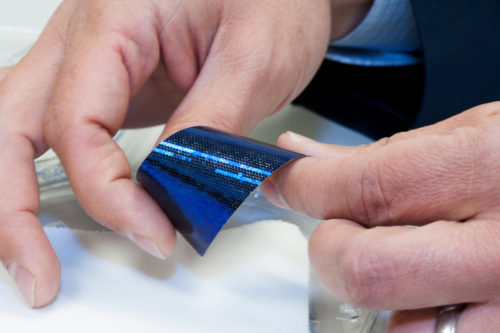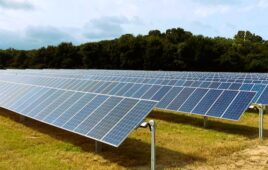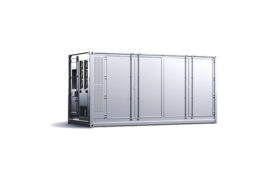In an industry focused on reducing cost, components and installation time, solar professionals have devised various system updates like shared rails and pre-attached electronics to improve the bottom line. Most developments happen when trying to reduce balance of system (BOS) costs. But what if significant cost and time savings can come with the solar panel itself, the inflexible (both literally and figuratively) core of every project?
New Mexico company mPower Technology is exploring that question with its tiny, tiny silicon solar technology it’s calling DragonSCALEs (SemiConductor Active Layer Embedded solar). By shrinking solar cells down and connecting them into blocks only a few millimeters wide, mPower can assemble “flexible” solar products that act like traditional high-efficiency solar panels but can be installed much faster.
 The idea for micro-solar applications was born at Sandia National Laboratories, where scientist Murat Okandan was working on microelectronics.
The idea for micro-solar applications was born at Sandia National Laboratories, where scientist Murat Okandan was working on microelectronics.
“I was involved in a quite diverse range of projects, some in biomedical implants and extremely precise sensors,” he said. “The way it came around [to solar], we looked at how we might be able to leverage the incredible capability that’s in microelectronics and microsystems and sort of merge them with what’s in terrestrial PV. The overall goal was to make solar much better, not in a sense of only higher efficiency, but also in terms of speed of deployment, operation and reliability.”
Okandan took his idea for microsystems-enabled photovoltaics (MEPV) and the IP portfolio that resulted from $20 million in R&D funding with additional resources from various groups to found mPower Technology in 2015. The company now has 24 patents, either through Sandia or on behalf of mPower, related to pixel-sized silicon solar cells that can be assembled into mesh-like solar panels. DragonSCALEs joins blocks of silicon cells in series and parallel through back-contact connections.
“We’re able to get to high voltages very quickly and not need as much metal, so that’s weight savings and cost savings,” Okandan said. “The interconnected mesh of these cells also brings resilience in terms of electrical performance. If you shade a portion of that single unit, only that portion that’s shaded isn’t producing power. Everything else is still connected and power is being pulled out.”
Silicon in itself is rigid, which is often the problem with traditional large-size crystalline silicon solar cells — there is no flexibility. They have to have structural support, often through glass. mPower’s pixel-sized silicon cells are still rigid, but their smaller size allows the overall module to be a little more malleable and flexible along the grid-like interconnects.
While thin-film solar panels can be flexible and other silicon startups are exploring advanced structural options, mPower execs think their micro product lends more advantages. Kevin Hell came on board as CEO in 2019 to prepare the company for its ramp-up in three main markets: space, traditional PV and internet-of-things (IOT). Space applications need low-cost, robust solar panels that can be “rolled” or “folded” to take up less space on a rocket. Traditional PV markets are also looking for powerful, lightweight and easily deployable systems. And the IOT market wants to power sensors, wearables, biomedical applications and more with small, flexible options. mPower will cater to all three markets with tiny silicon cells.
“The silicon trade is incredibly mature and robust in both manufacturing and volumes,” Hell said. “If you look at scaling, silicon is really the only viable option. It comes down to supply chain and economies of scale, and silicon is by far the leader there.”
mPower is currently manufacturing samples that are going through extreme testing for space environments. If the panels can survive the intensity of outer space, terrestrial applications will fare just fine. Hell said he expects the MEPV technology will reach the space market first, but the company is engaged with solar partners in the traditional residential and commercial solar markets already — some rooftop material companies looking to get into the solar market and existing solar providers looking for a new product to license.
“Our approach to market is to partner with major players that already have distribution,” Hell said. “They’ll license our technology and do joint development efforts.”
Okandan said mPower isn’t interested in being its own solar panel manufacturer.
“Looking at the key driver of how [to] make solar deployment faster and better, we were able to pick the right pieces and leverage them with our technology to overcome some of the challenges that were there before,” he said. “We’re looking for the right partners in whatever supply chain or whatever delivery mechanism makes the best sense for whatever that product is.”
Okandan envisions both easily deployed solar panels for the commercial market and solar shingles for the residential market. Maybe long solar panels are rolled out onto a flat commercial roof or a flexible mesh of solar cells conforms to a solar tile’s shape. Since mPower wants to tap into the established silicon and semiconductor supply chains, the pixel-solar products will have similar output and efficiency ratings as traditional solar, but the real advantages will be in reduced cost, faster installation and improved resiliency.
“Really the big benefit is balance of system cost and lower installation cost,” Okandan said. “All the things on top of the roof, we can be completely different.”
Hell said mPower expects its pixel solar technology to enter the space market very soon and the traditional PV market by next year. Mostly, the company is excited to help bring solar to new areas.
“We can enable completely new paradigms around how you install solar,” Hell said.





A big shout out to this innovative New Mexico company and Sandia National Labs!! The Land of Enchantment has the Sun and the Smarts to become a global leader in Solar Power!!
Good Stuff